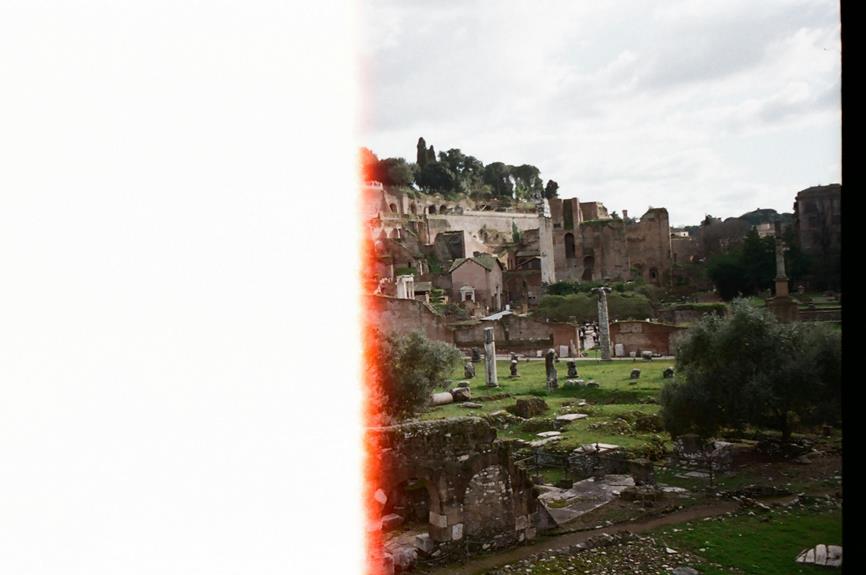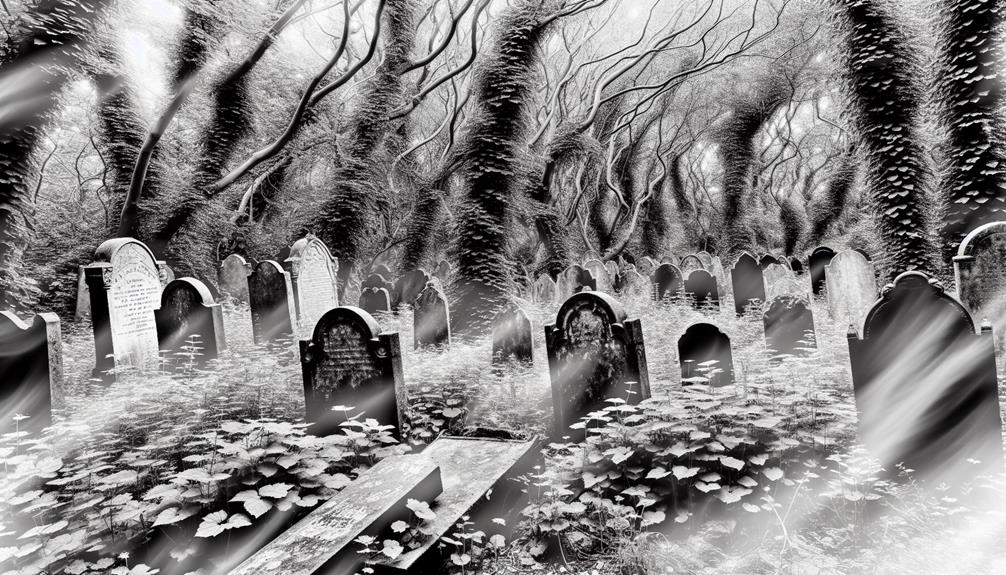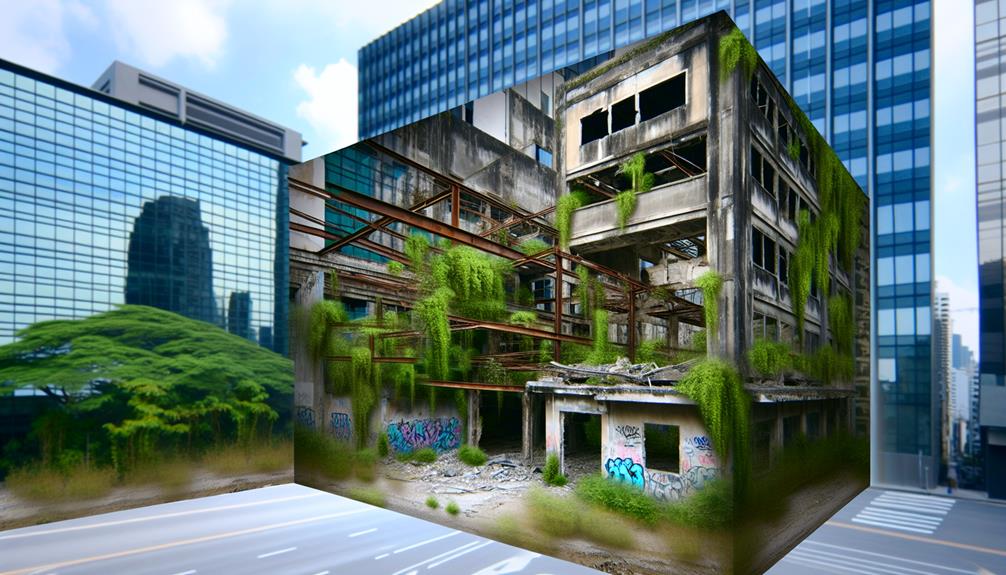Centralia, USA, stands as a cautionary tale of a community forever altered by the consequences of its industrial past. The enduring underground fire, shrouding the town in an unsettling mist, raises questions about the delicate balance between progress and preservation. As the abandoned streets whisper echoes of a once-thriving town, the implications of Centralia's fate linger, inviting contemplation on the price of progress and the ghosts of history that continue to shape our present.
Key Takeaways
- Centralia, USA, has had underground fires since 1962.
- Evacuation occurred due to unsafe carbon monoxide levels.
- Town remains frozen in time with abandoned buildings.
- Eerie atmosphere persists with smoke rising from fissures.
- Graffiti highway attracts artists and visitors.
The History of Centralia
The history of Centralia, a small town in the state of Pennsylvania, is marked by a series of significant events that have shaped its development over the years. Centralia's history is deeply intertwined with coal mining, a crucial industry that once thrived in the region. The town's prosperity was primarily driven by the rich coal deposits found underground, attracting many miners and their families to settle in the area.
However, Centralia's fortunes took a drastic turn due to underground fires that began in the coal mines. These fires, which started in 1962, proved to be a turning point in the town's history. The fires, believed to have been ignited in a landfill, spread to the underground coal seams, creating a hazardous and virtually unstoppable inferno beneath the town's surface.
As the underground fires raged on, Centralia faced a growing crisis that eventually led to the relocation of its residents. The fires not only posed significant environmental and safety concerns but also rendered the town uninhabitable. Despite efforts to extinguish the fires, they continue to burn to this day, serving as a haunting reminder of Centralia's tumultuous past and the enduring challenges posed by its coal mining legacy.
Coal Mining Boom
Experiencing a surge in economic activity, Centralia witnessed a rapid expansion of its coal mining industry during the late 19th century. The discovery of rich coal deposits in the region led to a boom in mining operations, attracting workers and investors alike. This economic prosperity brought a wave of growth to Centralia, transforming it into a bustling hub of coal production.
The impact on the community was profound. The influx of jobs in the coal mines provided employment opportunities for many residents, leading to an increase in population as people migrated to Centralia in search of work. This population growth, in turn, fueled the development of infrastructure such as housing, schools, and businesses to support the expanding community.
Moreover, the economic prosperity generated by the coal mining boom boosted local businesses, creating a ripple effect that stimulated the overall economy of Centralia. As coal production increased, so did the demand for goods and services, further driving growth and investment in the town.
However, alongside the economic benefits, the coal mining boom also brought challenges. Issues such as labor disputes, environmental concerns, and safety hazards in the mines emerged, highlighting the complex nature of Centralia's rapid industrial development. Despite these challenges, the coal mining boom left a lasting impact on Centralia, shaping its identity as a town built on the foundation of coal mining.
The Silent Hill Connection
During the exploration of Centralia's history, a significant connection emerges with the renowned video game and film franchise, Silent Hill. Centralia, a town in Pennsylvania, has drawn comparisons to Silent Hill due to its eerie atmosphere and the inspiration it provided for the creation of the fictional town in the Silent Hill series.
Silent Hill is known for its foggy, desolate setting, where dark forces lurk in a town overcome by a coal mine fire. Similarly, Centralia's underground coal mine fire has been burning since 1962, leading to the town's evacuation and creating a haunting landscape of smoke-filled streets and abandoned homes. This real-life tragedy mirrors the fictional horror of Silent Hill, where an alternate dimension filled with darkness and ash stirs psychological terror on those who dare to enter.
The dilapidated buildings, cracked roads, and pervasive sense of abandonment in Centralia have sparked the imagination of fans and creators alike, influencing the visual and thematic elements of the Silent Hill franchise. The connection between Centralia and Silent Hill serves as a reminder of the unsettling power of real-world events to inspire fictional tales of horror and mystery, blurring the lines between reality and imagination for those who explore these eerie landscapes.
Abandonment and Evacuation
Abandonment and evacuation of Centralia began as the underground coal mine fire continued to pose a threat to the town's residents and infrastructure. The evacuation process was a challenging ordeal for the community as they grappled with leaving behind their homes and memories. Despite the emotional turmoil, the residents understood the necessity of the evacuation for their safety.
Community resilience played a crucial role during the abandonment and evacuation phase. The tight-knit community banded together to support one another through this difficult time. Many residents found solace in each other's company, offering help and comfort as they navigated the process of leaving Centralia behind. This sense of unity helped alleviate some of the stress associated with the evacuation.
As the evacuation progressed, homes were abandoned, and the once-thriving town became a ghost town. Streets that were once bustling with life now stood empty, a stark reminder of the town's abandonment. The evacuation process was a somber affair, marking the end of an era for Centralia.
Despite the challenges faced during the abandonment and evacuation, the community of Centralia showed remarkable strength and resilience. Their ability to come together in the face of adversity is a tribute to the human spirit and the power of community support.
The Eternal Flame
The underground coal mine fire in Centralia, USA continues to burn to this day, giving rise to the eerie and enduring phenomenon known as the Eternal Flame. This mysterious underground fire has captivated visitors and researchers alike, drawing attention to the town's unique and haunting presence.
- Unquenchable Blaze: The underground fire, fueled by coal seams, stubbornly refuses to be extinguished despite numerous attempts over the years.
- Visible Smoke: Wisps of smoke rising from fissures in the ground provide a visible reminder of the fire's relentless burn beneath the surface.
- Heat Waves: The ground above the burning coal mine is often warm to the touch, creating a surreal experience for those who venture near the affected areas.
- Sulfurous Odor: The air carries a distinctive smell of sulfur, adding to the otherworldly atmosphere surrounding the Eternal Flame.
This ongoing underground fire serves as a poignant reminder of Centralia's troubled past and uncertain future. The Eternal Flame stands as a proof to the power of nature and the resilience of the human spirit in the face of an enigmatic and enduring force.
Graffiti Highway
Once a bustling roadway, Graffiti Highway in Centralia, USA has transformed into a vibrant canvas of artistic expression. This stretch of abandoned Route 61, closed due to the underground mine fire burning since 1962, has become a mecca for urban exploration enthusiasts and artists alike.
Exploring art on Graffiti Highway offers a unique experience where individuals can freely express themselves through colorful murals, graffiti tags, and intricate street art. The layers of paint that now cover the asphalt tell a story of creativity, resilience, and rebellion against the backdrop of a town forever changed by the forces of nature.
Urban exploration on Graffiti Highway provides a glimpse into the intersection of art and abandonment. Visitors can wander along the cracked pavement, marveling at the ever-evolving gallery of graffiti that adorns the road. Each piece of art adds to the collective narrative of this unconventional outdoor exhibition, inviting spectators to interpret the messages, emotions, and meanings behind the spray-painted symbols.
In the heart of Centralia, Graffiti Highway stands as a symbol of the power of art in reclaiming forgotten spaces and sparking dialogue. It remains a symbol of freedom of expression, attracting adventurers and artists from far and wide to witness the beauty that emerges from decay and destruction.
Legal Battles and Demolitions
Facing a series of legal battles and impending demolitions, the future of Graffiti Highway in Centralia, USA hangs in the balance. The community is torn between preserving a symbol of their resilience and complying with legal mandates for safety and environmental concerns. Here are some key points to ponder:
- Legal Battles: Various legal challenges have arisen regarding the ownership of the land where Graffiti Highway stands and the liability associated with allowing visitors to access the site.
- Zoning Regulations: The local authorities are enforcing zoning regulations that restrict public access to the area due to safety hazards posed by the underground mine fire.
- Demolition Orders: Court-ordered demolition plans are looming over Graffiti Highway, with authorities pushing for the removal of the asphalt to prevent further public exposure to the mine fire's risks.
- Community Resilience: Despite the legal hurdles, the community is rallying to find alternative solutions that would allow some form of preservation or commemoration of Graffiti Highway as a symbol of their enduring spirit in the face of adversity.
As the legal battles intensify and demolition deadlines approach, Centralia's residents are grappling with a delicate balance between honoring their past and ensuring a safe and sustainable future for their town.
Environmental Impact
Amidst the legal disputes and impending demolitions surrounding Graffiti Highway in Centralia, USA, a pressing concern emerges regarding the environmental impact of maintaining or removing the site. The prolonged underground coal fire in Centralia has led to significant pollution consequences over the years. The fire has continuously released toxic gases and particulate matter into the air, posing serious health risks to the residents and visitors of the area. Removing the site entirely could potentially help in reducing further pollution and mitigating these health hazards.
Moreover, the environmental impact of maintaining Graffiti Highway must also be considered. The constant upkeep of the site generates waste and requires resources that may further harm the environment. By evaluating the pollution consequences of both scenarios, a more informed decision can be made regarding the future of Graffiti Highway.
In terms of community restoration, addressing the environmental impact is vital. Restoring the environment in Centralia is not just about cleaning up the visible effects of the coal fire; it also involves creating a safe and healthy space for the community. Whether through remediation efforts or site removal, prioritizing the well-being of the residents and the environment is essential for the long-term sustainability and restoration of Centralia.
Centralia Today
With the coal fire still burning underground, Centralia today remains a stark reminder of the enduring environmental and social challenges faced by its residents. Despite these challenges, the community has shown remarkable resilience in adapting to the situation.
Some key aspects of Centralia today include:
- Ongoing Underground Fire: The coal fire that ignited in 1962 continues to burn beneath the town, releasing toxic gases and causing ground subsidence.
- Modern Developments: In recent years, efforts have been made to modernize certain aspects of Centralia, such as infrastructure improvements and technological enhancements.
- Community Resilience: The residents of Centralia have come together to support one another and rebuild their town in the face of adversity, showcasing a strong sense of community resilience.
- Limited Population: The population of Centralia has decreased over the years, with only a few residents choosing to remain in the town despite the ongoing challenges.
Centralia today stands as a unique example of a community grappling with a long-standing environmental disaster while aiming for modern developments and demonstrating remarkable community resilience. The town's complex history serves as a cautionary tale and a proof of the strength and perseverance of its residents.
Visiting Centralia
Visitors to Centralia, drawn by its unique history and ongoing environmental challenges, are met with a landscape that tells a story of resilience and transformation. Centralia's most striking feature is the underground fires that have been burning since 1962, leading to the town's evacuation due to unsafe levels of carbon monoxide. Despite the risks, many visitors are intrigued by the mysterious allure of Centralia and come to witness the effects of the ongoing underground fires.
Exploring the ruins of Centralia offers a glimpse into a town frozen in time, with empty streets and abandoned buildings covered in graffiti. The cracked highways and smoke rising from fissures in the ground create an eerie atmosphere that fascinates those who dare to venture into this forbidden town. The graffiti highway, a section of Route 61 closed due to the underground fires, has become a canvas for artists and visitors leaving their mark on Centralia's scarred landscape.
While the dangers of the underground fires persist, visitors are reminded of the power of nature and the consequences of human intervention. Centralia stands as a stark reminder of the lasting impact of environmental disasters and the importance of responsible land management. Despite its desolate appearance, Centralia continues to attract curious explorers seeking to uncover the secrets hidden beneath the surface of this once-thriving community.
Frequently Asked Questions
Is It Safe to Visit Centralia?
When considering the safety of visiting any location, it is essential to research safety precautions to guarantee a smooth and enjoyable experience. Familiarizing oneself with local laws and customs, staying informed about current events, and being mindful of personal belongings are key aspects of maintaining safety while traveling.
Additionally, exploring tourist attractions can enrich the travel experience, offering insights into the culture and history of the destination.
Can the Fire in Centralia Be Extinguished?
In the domain of persistent underground fires, the challenge of extinguishing them poses intricate hurdles. Fire containment strategies often involve extensive measures due to the environmental impact and risks involved. Government intervention is vital, but may lead to community displacement in extreme cases.
Addressing such fires requires a holistic approach that balances safety, environmental concerns, and community well-being. Efforts must be strategic, considering various factors to effectively tackle such challenging situations.
Are There Any Residents Still Living in Centralia?
Residents of the area have faced challenges due to ongoing issues. Relocation efforts have been initiated to safeguard the safety and well-being of those affected.
The survival of the community relies on effective community engagement to address the complex situation. As the situation unfolds, efforts are being made to support residents and facilitate a successful shift to new environments.
How Did the Graffiti Highway in Centralia Come About?
The 'Graffiti Highway' originated as a pathway for expression and creativity, gradually evolving into a symbol of cultural significance. Its history is intertwined with the community's desire for artistic freedom and self-expression.
Over time, this route has become a unique canvas for individuals to leave their mark and contribute to a collective narrative. The highway's transformation reflects a fusion of personal stories and societal commentary, making it a notable landmark for those seeking creative outlets.
What Are the Long-Term Health Effects of the Underground Fire?
Long-term exposure to underground fires can lead to severe health consequences. Respiratory issues such as chronic coughing, chest pain, and difficulty breathing may arise due to the release of toxic gases and particulate matter. Additionally, cancer risk may increase from prolonged exposure to carcinogens released by the fire.
The environmental impact of underground fires can have detrimental effects on public health, necessitating continuous monitoring and mitigation efforts to safeguard community well-being.
Conclusion
In the desolate landscape of Centralia, the haunting remnants of a once thriving coal mining town stand as a stark reminder of the destructive power of the underground fire that continues to burn relentlessly.
The eerie atmosphere, akin to a scene from a horror film, evokes a chilling sense of abandonment and despair.
Centralia's legacy is etched in the eternal flame that flickers amidst the ruins, a symbol of a community forever scarred by tragedy.


